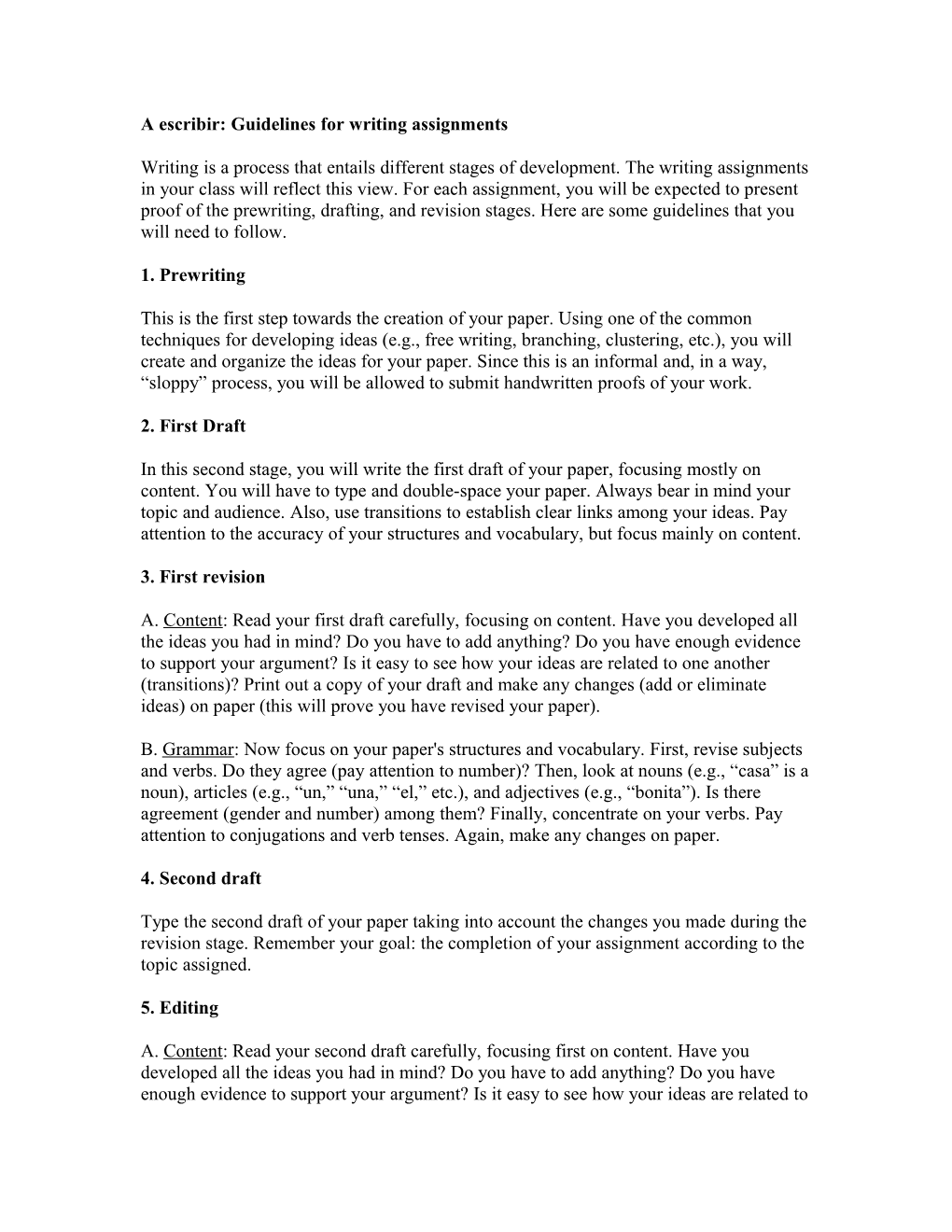A escribir: Guidelines for writing assignments
Writing is a process that entails different stages of development. The writing assignments in your class will reflect this view. For each assignment, you will be expected to present proof of the prewriting, drafting, and revision stages. Here are some guidelines that you will need to follow.
1. Prewriting
This is the first step towards the creation of your paper. Using one of the common techniques for developing ideas (e.g., free writing, branching, clustering, etc.), you will create and organize the ideas for your paper. Since this is an informal and, in a way, “sloppy” process, you will be allowed to submit handwritten proofs of your work.
2. First Draft
In this second stage, you will write the first draft of your paper, focusing mostly on content. You will have to type and double-space your paper. Always bear in mind your topic and audience. Also, use transitions to establish clear links among your ideas. Pay attention to the accuracy of your structures and vocabulary, but focus mainly on content.
3. First revision
A. Content: Read your first draft carefully, focusing on content. Have you developed all the ideas you had in mind? Do you have to add anything? Do you have enough evidence to support your argument? Is it easy to see how your ideas are related to one another (transitions)? Print out a copy of your draft and make any changes (add or eliminate ideas) on paper (this will prove you have revised your paper).
B. Grammar: Now focus on your paper's structures and vocabulary. First, revise subjects and verbs. Do they agree (pay attention to number)? Then, look at nouns (e.g., “casa” is a noun), articles (e.g., “un,” “una,” “el,” etc.), and adjectives (e.g., “bonita”). Is there agreement (gender and number) among them? Finally, concentrate on your verbs. Pay attention to conjugations and verb tenses. Again, make any changes on paper.
4. Second draft
Type the second draft of your paper taking into account the changes you made during the revision stage. Remember your goal: the completion of your assignment according to the topic assigned.
5. Editing
A. Content: Read your second draft carefully, focusing first on content. Have you developed all the ideas you had in mind? Do you have to add anything? Do you have enough evidence to support your argument? Is it easy to see how your ideas are related to one another (transitions)? Print out a copy of your draft and make any changes (add or eliminate ideas) on paper.
B. Grammar: Now focus on your paper's structures and vocabulary. First, revise subjects and verbs. Do they agree (pay attention to number)? Then, look at nouns (e.g., “casa” is a noun), articles (e.g., “un,” “una,” “el,” etc.), and adjectives (e.g., “bonita”). Is there agreement (gender and number) among them? Finally, concentrate on your verbs. Pay attention to conjugations and verb tenses. Again, make any changes on paper.
Final stage: Mission accomplished!
Type the final version of your paper incorporating the changes you made during the editing stage. Print your paper and submit it with the prewriting paper and drafts. Staple all the documents together. On your final version, don't forget to include the date, your name, your instructor's name, your course number, the title of your paper, and the number of words.
LATE ASSIGNMENTS OR THOSE THAT DO NOT COMPLY WITH THESE GUIDELINES WILL NOT BE ACCEPTED.
